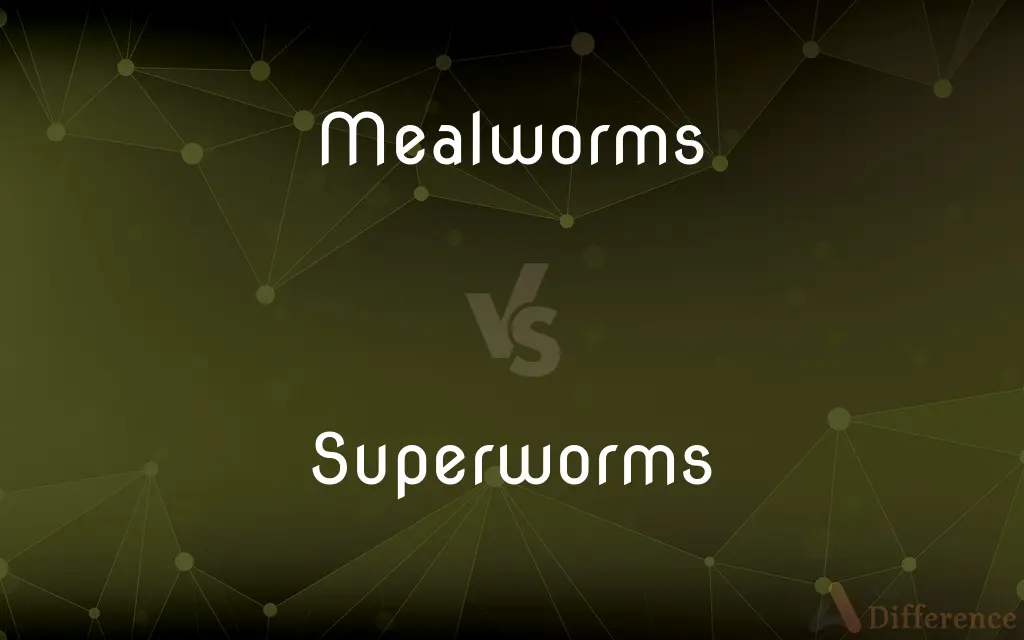Mealworms vs. Superworms — What's the Difference?
Edited by Tayyaba Rehman — By Fiza Rafique — Published on March 1, 2024
Mealworms are small, nutrient-rich insects ideal for feeding pets and used in composting, while superworms are larger, have a higher fat content, and require individual housing to pupate.

Difference Between Mealworms and Superworms
Table of Contents
ADVERTISEMENT
Key Differences
Mealworms, the larval form of the Tenebrio molitor beetle, are known for their high protein content and ease of breeding, making them a popular choice for pet feed, especially for reptiles, birds, and fish. Superworms, on the other hand, are larvae of the Zophobas morio beetle, and due to their larger size and higher fat content, are favored for feeding larger pet species that require more substantial meals.
Mealworms can be easily stored in a refrigerator to slow down their metabolism and prolong their larval stage, while superworms must not be refrigerated as they require a warmer environment to remain active and healthy. This difference in storage requirements is crucial for pet owners to ensure the longevity and quality of their feed.
Mealworms are often praised for their role in waste reduction and composting, as they can consume a variety of organic matter, turning it into nutrient-rich compost. Superworms, although also capable of composting, are less commonly used in this capacity due to their more specific care requirements and larger size, which makes them less efficient in smaller-scale composting systems.
The breeding process also differs significantly; mealworms can be bred in large groups with minimal space, making them a more accessible option for those looking to cultivate their own feedstock. Superworms require individual containers for pupation to prevent cannibalism, making their breeding process more labor-intensive and less space-efficient.
In terms of nutritional content, mealworms offer a balanced diet but with slightly less fat compared to superworms, making them a healthier choice for animals with lower fat dietary requirements. Superworms, with their higher fat and calorie content, are best suited for occasional treats or for species that benefit from a richer diet.
ADVERTISEMENT
Comparison Chart
Size
Smaller (1.25 to 1.5 inches)
Larger (2 to 2.25 inches)
Fat Content
Lower
Higher
Housing Requirements
Can be kept in groups
Require individual housing for pupation
Best Used For
Regular feeding for small to medium pets
Occasional treats or larger pets
Refrigeration
Can be refrigerated to slow metabolism
Should not be refrigerated
Compare with Definitions
Mealworms
Can be refrigerated to extend their larval stage.
To keep mealworms longer, they are stored in the fridge at a low temperature.
Superworms
Serve as a richer, fattier treat for pets.
Superworms are given as treats to pets requiring extra fat in their diet.
Mealworms
Suitable for composting organic waste into nutrient-rich soil.
Adding mealworms to compost bins accelerates the decomposition process.
Superworms
Larval form of the Zophobas morio beetle, known for their size and fat content.
Superworms provide a hearty meal for larger reptile pets.
Mealworms
Larval stage of the Tenebrio molitor beetle, used as high-protein pet food.
Mealworms are often fed to chickens to increase their protein intake.
Superworms
Need individual containers for pupation to prevent cannibalism.
Each superworm is separated into its own compartment for breeding.
Mealworms
Easily bred in captivity for sustainable feed.
Mealworms are bred in bulk to provide a continuous food supply for pets.
Superworms
Require warm temperatures and cannot be refrigerated.
Superworms are kept at room temperature to maintain their health.
Mealworms
Smaller and less fatty compared to superworms.
For pets on a diet, mealworms are preferred over superworms due to their lower fat content.
Superworms
Not as widely used in composting due to specific care requirements.
Superworms are less common in compost bins than mealworms.
Mealworms
A larva of any of various darkling beetles, especially Tenebrio molitor, which infests flour and other grain products and is often used as food for birds and reptiles and as fish bait.
Superworms
Plural of superworm
Mealworms
Plural of mealworm
Common Curiosities
How do I breed mealworms or superworms?
Mealworms can be bred in groups with minimal space, while superworms require individual containers to prevent cannibalism during pupation.
Are mealworms or superworms better for feeding pets?
It depends on the pet's size and dietary needs; mealworms are generally better for regular feeding due to their lower fat content, while superworms are suited for larger pets or as occasional treats.
Can I refrigerate superworms like mealworms?
No, superworms should not be refrigerated as they require warmer temperatures to stay healthy.
What are mealworms used for?
Mealworms are primarily used as feed for pets like reptiles, birds, and fish, and for composting.
Why can't superworms be refrigerated?
Refrigerating superworms can harm them because they require a constant warm environment to stay active and healthy.
What makes superworms different from mealworms?
Superworms are larger, have a higher fat content, and require individual housing for pupation, unlike mealworms.
Can mealworms be used in composting?
Yes, mealworms can consume organic matter and are beneficial in composting processes.
What is the nutritional difference between mealworms and superworms?
Mealworms have a lower fat content, making them a healthier option for regular feeding, while superworms are higher in fat and suited for richer diets.
Can all pets eat superworms?
Not all pets should eat superworms regularly due to their high fat content; they are best for larger pets or as treats.
How long do mealworms and superworms live?
The lifespan can vary, but generally, both can live for several months under optimal conditions.
Is it easy to breed mealworms at home?
Yes, mealworms are easy to breed at home in bulk, making them a sustainable option for pet food.
Do superworms require special care?
Yes, superworms need to be kept at room temperature and cannot be refrigerated, and they require individual containers for breeding.
Are superworms used in composting?
While superworms can be used in composting, they are less common due to their specific care requirements.
Are mealworms or superworms better for the environment?
Both can be environmentally beneficial; mealworms are more commonly used in composting, making them slightly more eco-friendly.
Can superworms be bred in the same way as mealworms?
No, superworms require individual housing for successful breeding, unlike the group housing feasible for mealworms.
Share Your Discovery

Previous Comparison
Frequency vs. Relative Frequency
Next Comparison
Seeds vs. BeansAuthor Spotlight
Written by
Fiza RafiqueFiza Rafique is a skilled content writer at AskDifference.com, where she meticulously refines and enhances written pieces. Drawing from her vast editorial expertise, Fiza ensures clarity, accuracy, and precision in every article. Passionate about language, she continually seeks to elevate the quality of content for readers worldwide.
Edited by
Tayyaba RehmanTayyaba Rehman is a distinguished writer, currently serving as a primary contributor to askdifference.com. As a researcher in semantics and etymology, Tayyaba's passion for the complexity of languages and their distinctions has found a perfect home on the platform. Tayyaba delves into the intricacies of language, distinguishing between commonly confused words and phrases, thereby providing clarity for readers worldwide.
















































